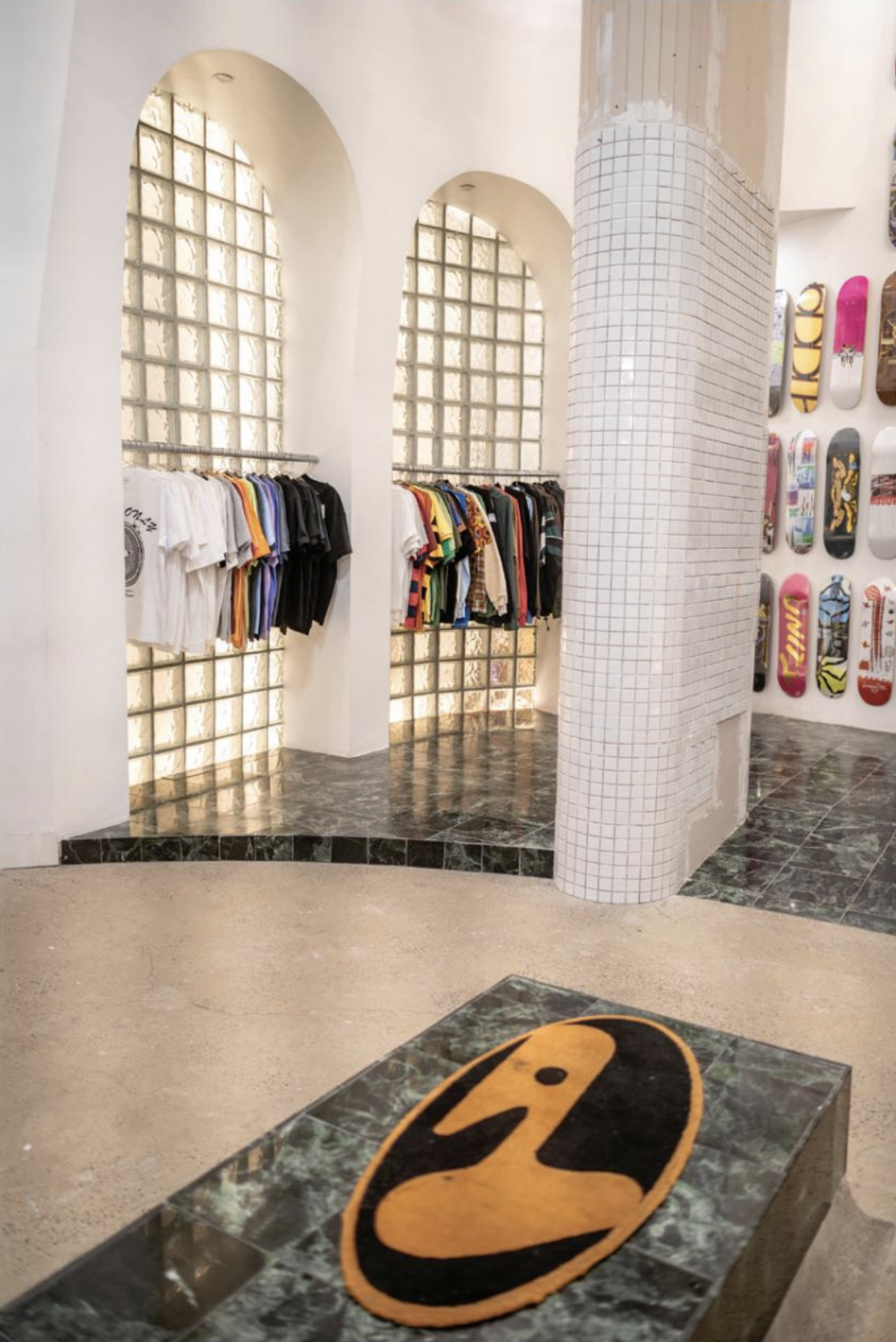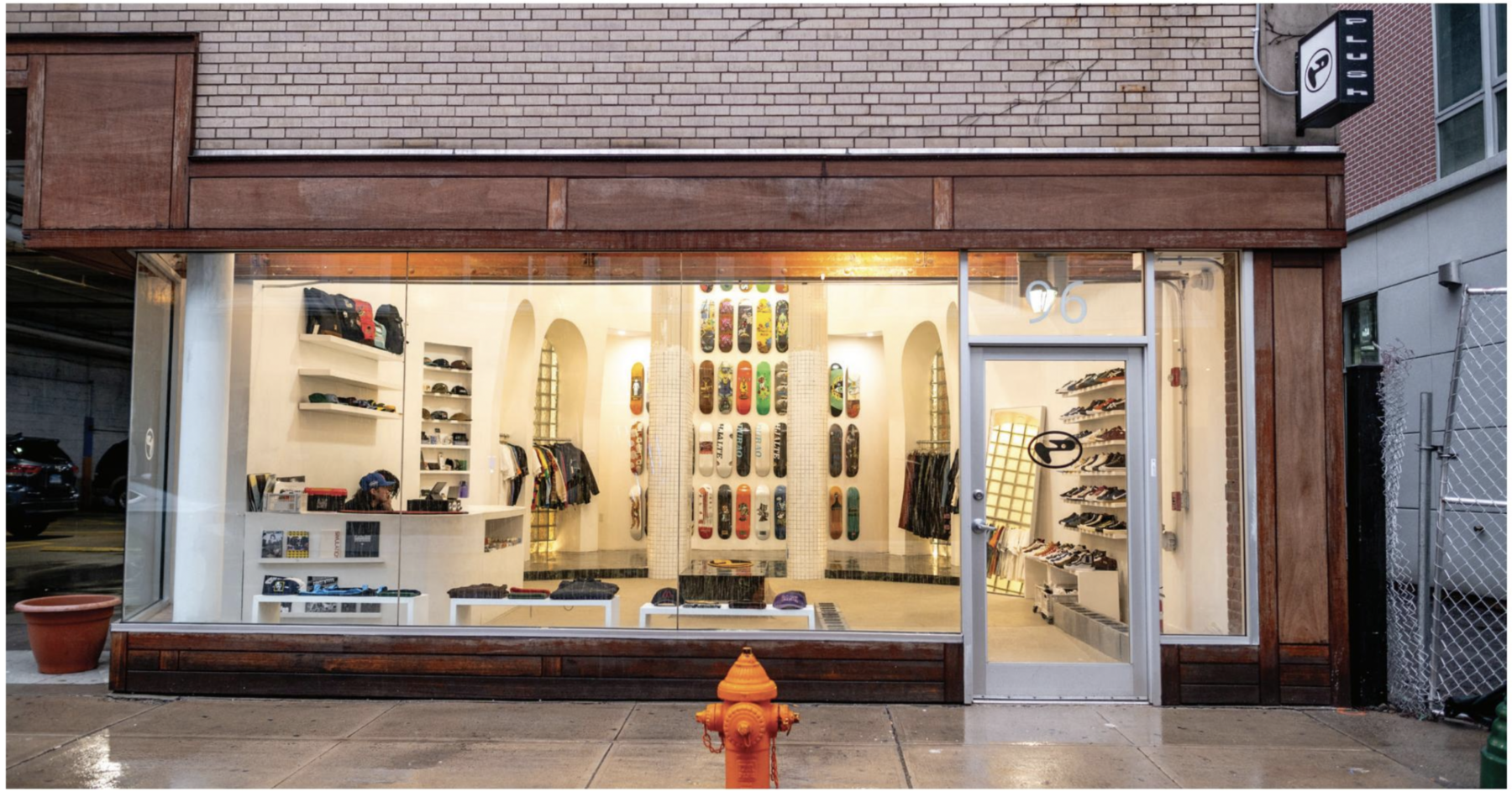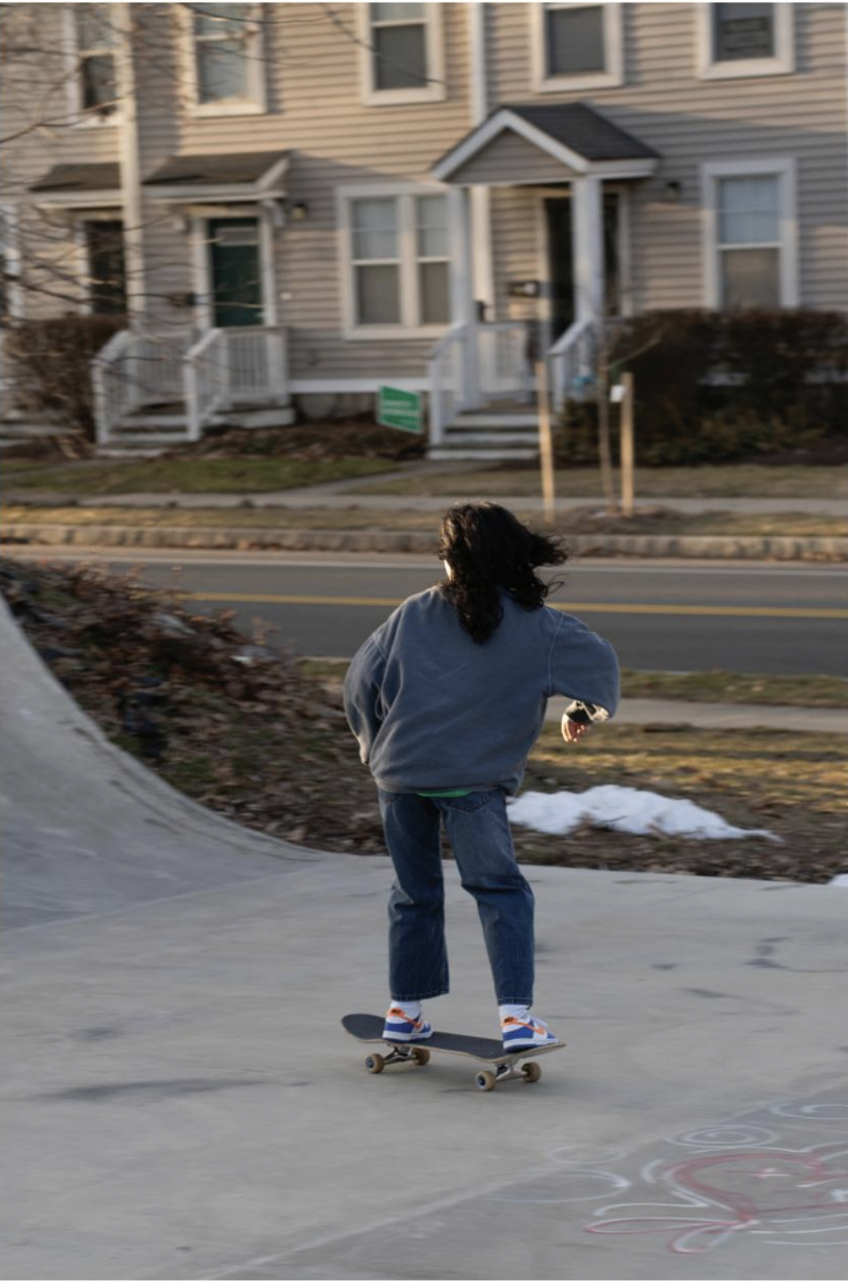If you turn left from Chapel Street onto Orange Street and walk about a block, chances are you’ll see a group of teenagers performing kickflips and ollies on the pavement. They’ll be outside a storefront with a giant wall of glass. That’s Plush: New Haven’s only dedicated skate shop, decorated with colorful skateboard decks and populated with the trendiest gear on the market.
Sir-Michael Burrow is the employee behind Plush’s white, rounded counter. As soon as I walk in, he shoots me a big smile and waves me over. “Feel free to ask any questions about anything in shop, and I’ll pull it out for you,” he says. He’s sporting a simple white t-shirt and blue jeans, nothing flashy. His outfit blends in with the plain white wall behind him. White accents—they’re everywhere. They contrast sharply with the colorful racks of clothes that hang a few feet from him, displaying popular brands such as Carhartt, Dickies, and Converse.

Burrow is from Waterbury, Connecticut, and has been skating in New Haven since he was 17. Now, at 25, he has a glint in his eyes when he talks about skating. He’s flanked by containers overflowing with skate periodicals and poster books.
Burrow’s favorite word is “sidebar.” As we begin to talk about Plush and its connection to New Haven skating, he throws it into our conversation to add more context to the growth of Connecticut’s skating culture. “Just a sidebar,” he says. “Another sidebar.”
Sidebar: a skate video filmed in Connecticut in the nineteen-nineties called Mama’s Boys brought more skaters to the city and revitalized New Haven’s scene. Sidebar: When Plush opened, Vans came and shot a piece that put New Haven on the map again. Sidebar: for the past few decades, a vibrant skate film culture has been brewing in the city.
Before Plush opened in 2021, the last skateboarding shop in the city closed in 2012. The closure left New Haven skaters with only two shop options in the state of Connecticut: Hive in New London and Cutting Edge in Berlin, both more than a thirty-minute drive away.
Alexis Sablone, an Olympic skateboarder, and Trevor Thompson, also a professional skater, both grew up around New Haven and recognized the inaccessibility of centralized hubs for skating culture in their home state and city. They decided to open Plush, harnessing the power of the local skateboarding community, and the expertise of Connecticut-area skaters like Burrow, to bring the shop to life.
Burrow tells me that their industry connections as professional skaters made the opening process seamless.
“Anyone can open a skate shop, but, like, you need to know what the hell’s actually going on in the trend scene and what companies are cool like the back of your hand,” Burrow said. “As pros, Alexis and Trevor are friends with people who are pros. It’s about being plugged in.”
Rifling through the clothing racks of the store—organized by color to create a rainbow of choices—you’ll find high-end skate brands ranging from the more commercial Vans to the Colorado-based Polar Skate Co. Behind the hanging clothes is a mural of skate decks and boards; to the left of them, you’ll find a wall displaying the most trendy sneakers on the market. The highly-curated selection of options in Plush and the aesthetic of their presentation make it feel like not just a skate shop, but an art gallery.
Plush’s role in New Haven isn’t really retail, though. It’s to create a space where New Haven skaters can come together and build camaraderie.
Plush holds monthly events, like skate video screenings and pop-up vintage markets. “It’s a meet up place,” Burrow says. “You have everyone knowing that there’s this one place where they can come together and, you know, skate together whenever.”
Community hubs like Plush naturally function as sites for structural change, too. As a centralized location for skaters, Plush has been instrumental in advocating for more skating spaces in New Haven. The majority of this advocacy can be tied back to Ben Berkowitz, co-owner of Plush.
Since lending a hand to Sablone and Thompson in the opening of Plush, Berkowitz, who is also a local skater, has used the scale of Plush’s wide-reaching community as proof to the city of the need for more skating locations. He’s been successful. Berkowitz worked with New Haven and the Parking Authority Board to transform Temple Street Parking Garage, a formerly unofficial skating hub, into an official indoor skatepark. With his encouragement, city leaders opened Scantlebury Park, a skatepark on Ashmun Street, and a new skating bowl on George Street in 2021, shortly after Plush’s opening.
However, the preservation of street skating, an essential part of skateboarding culture, has been harder to reconcile with the city—and with Yale.
While street skating is not technically illegal in New Haven, it is heavily policed, especially on and around Yale’s campus. Beinecke Plaza, a popular skate spot, is often patrolled by Yale Security personnel, and skaters have faced backlash—including removal—for trying to skate it and other parts of campus.
“Street skateboarding… it’s kind of what makes skateboarding skateboarding,” Burrow says. “The spirit of resilience, of getting kicked out and coming back is a big portion of street skateboarding. Builds character.”
When I walked into Plush, Burrow had been laughing with four teenage boys, all decked in mostly-black baggy jeans and t-shirts. As soon as Burrow and I start talking, the boys flee to the street. I can still see them outside of Plush’s giant window, skating in circles around the block. One of the boys comes up and taps on the window, making a face at Burrow. He laughs.
“I’ve known these kids for a while because I’ve been skating out here for a few years,” Burrow says. “That’s another thing—skating, shops like these, it gives the kids a place to go instead of a bar or some other time-wasting thing. Skating is… it’s freedom. We’re giving them that here.”

I grew up skateboarding. Walking into Plush, I was instantly comforted by the familiarity of the shop’s environment, its palpably laid-back energy. Hip-hop music played softly over the loudspeakers as the teenagers around the counter laughed with Burrow. I could have met them in a skatepark back home—they were wearing the same outfits that were so recognizable to me, and had the same quippy way of speaking that felt like a constant challenge. Skating not only liberates; it also connects.
Another tap at the window. It’s been a few minutes since the last. Same kid—same face, small and covered by a mop of light-brown hair. Burrow’s eyes light up. It’s clear that these kids aren’t just shop regulars. They’ve become his friends.
Burrow strolls to the door and yells out into the chilly February evening. “Mead! Get in here.”
The kid—no older than 17—glides up to the door and steps in. He’s holding a mini, skateboard-shaped fidget toy. He comes up to me at the counter and gives me a nod. The fidget skateboard flips in his fingers.
Mead taps his foot on the ground. “Are you a student?”
When I nod my head yes, he looks at Burrow and takes a deep breath.
Mead has been skating for six years. “Not that long,” he assures me. His terrain is the street, not the parks. Echoing Burrow’s reflection on the power of street skating, he tells me that street skating preserves skating culture.
“A lot of people that don’t skate assume it’s all about the parks, but skating started on the street, it’s meant for the street,” he tells me. “Street skating is something you can learn from. You need dedication for it. It’s escapism. I use it to cope.”
For the first time in our conversation, he makes direct eye contact with me. “You go to Yale?”
I nod.
Yale’s Schwarzman Center has funneled thousands of dollars into local skatepark construction, including Scantlebury Park’s and the skate bowl on George Street. While the main publicized reason for this funding has been to support the cultural benefits of skateboarding, Mead thinks that the popularity of Beinecke as a skate spot acts as a secondary motivation.
“I’ve been wanting to tell someone this, so Yale should hear it. They have power,” he says. He flips his fidget skateboard on the counter. “Just because the city and Yale keep building these skateparks and stuff doesn’t mean that they change anything for us street skaters. Pouring money into that isn’t going to change the fact that we’re going to skate Beinecke.”
He articulates his final point with a passion that differs from his earlier drawl. “And if they really want us to stay off their property, don’t build the skateparks outside. Like, centralize it in the city. It’s a trek to get to the parks.”
He’s not wrong. The closest park to Plush is Scantlebury Park, located behind Pauli Murray College off of Ashmun Street. It’s a twenty-five-minute walk from Plush’s centralized, downtown location.
The next day, I make the journey up to Scantlebury, located off the Canal Trail. My jacket barely keeps me warm against the frigid wind. It beats at my face as I navigate the icy sidewalk. The playground next to the skatepark is, unsurprisingly, empty. As I trek up the short hill that leads to the base of the park, though, I can hear the click of wheels against asphalt. The only person within eyesight is a single skateboarder practicing tricks on the slopes.
His name is Michael Skirkanich. He’s middle-aged, definitely older than the kids I saw at Plush. Unlike them, he’s wearing a helmet. “Don’t want to crack my head open,” he says. When I sit down on the concrete next to the skatepark, we begin to talk about Scantlebury.

“I like being out here alone,” he tells me. “When I’m here, I don’t care about, think about anything else. It’s just skateboarding. Without the squirts—the teens—I can focus.”
As we’re talking, he pauses every so often to focus on a particular trick or flip. “I come out here seven, eight hours a day,” he explains. “I see every day as a good day or a training day.”
Unlike Mead, the skatepark is an essential space for Michael. It provides a structured space for him to focus on the “artistic” side of his skating craft.
After all, to him, skateboarding is, in one word, self-fulfillment. “Not many people can do this, and that fulfills me. Landing a trick, the sound, it’s like music, it fills me up.”
Music. He’s right. I’m reminded again of my own skating roots. I used to love the musicality of the sport, the rhythm of the wheels. I think that, in a strange way, my yearning for that feeling was what made me so interested in the presence of skateboarding on every street in New Haven—one of the first things I noticed about the city was how much skating was embedded into its culture. At street corners and in parks, on campus and off, there are skaters. The sound of wheels on asphalt is an essential part of the urban melody of my new home.
I stopped skateboarding when I was 15 because of a shoelace-in-wheel trip that left me in an arm cast for a month. Sitting criss-cross on the side of the curving, concrete slopes, I tell Skirkanich this. I tell him about the weird fear I have of stepping on a board now, about how it reminds me of the crack I heard—and the instant shoot of pain I felt—four years ago when I last did it. He scoffs.
“You’re telling me you broke your wrist four years ago and haven’t gotten back on a board? I broke my ankle. I’m here,” he says. I’m reminded of Burrow’s point: that skating is all about resilience. You just have to keep going for it. Skirkanich echoes him. “You have to keep trying, keep going for it.”
“Come stand on my board and you’ll see,” he says. “You gotta try.”
He waves me over, kicks his board towards me. “It’s all about baby steps.”
I balance myself on his board. He holds his arm out. “Hey, it’s nice. Mercedes of skateboards. Be careful,” he makes sure to let me know. For the first time in a long while, I feel the liberation of skating. How it is freedom, like Burrow told me, how it is self-fulfillment, like Michael tells me, and I get it. It clicks.
Back at Plush, Burrow left me with some words that pretty much sum it up. “New Haven, skating, music, culture, film, they all go hand in hand,” Burrow told me. “Skating is art. It needs to be treated like art. It needs to be respected like art.”
Art on the street—art in the park. Both go hand in hand. Skateboarding, as art, is an inherently public sport. It deserves space both in structured environments and in the city at large.
Stand on a board like I did, and maybe you’ll get it too.
— Zoya Haq is a first-year in Saybrook College.
Photography by Ellie Park and Tashroom Ahsan.

